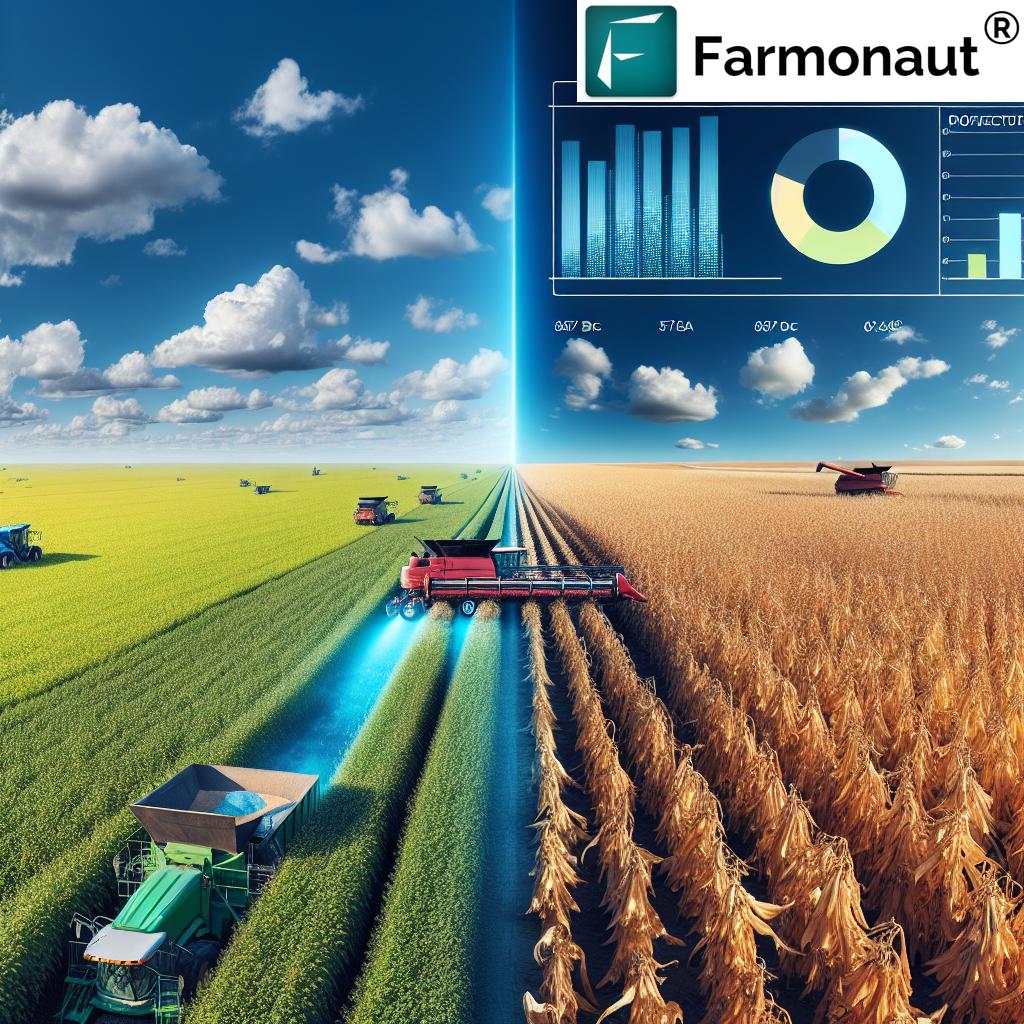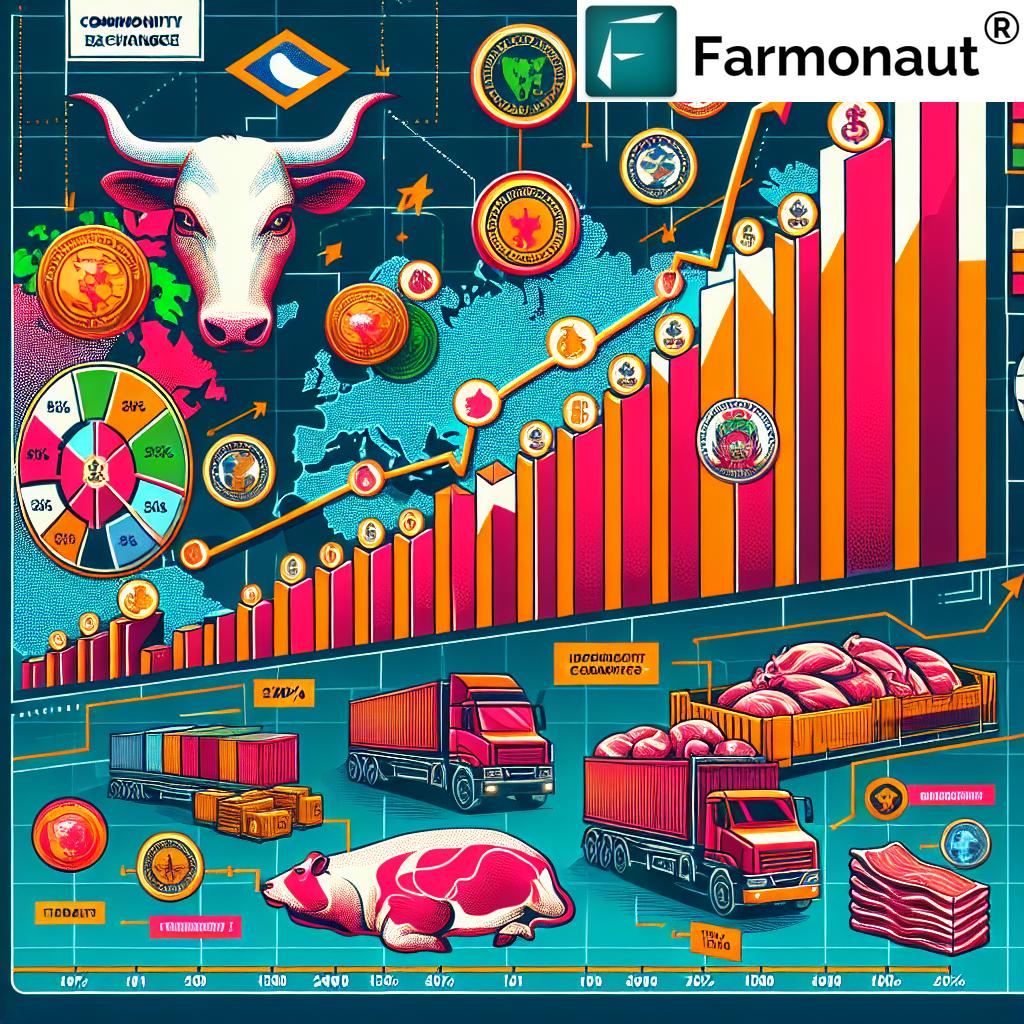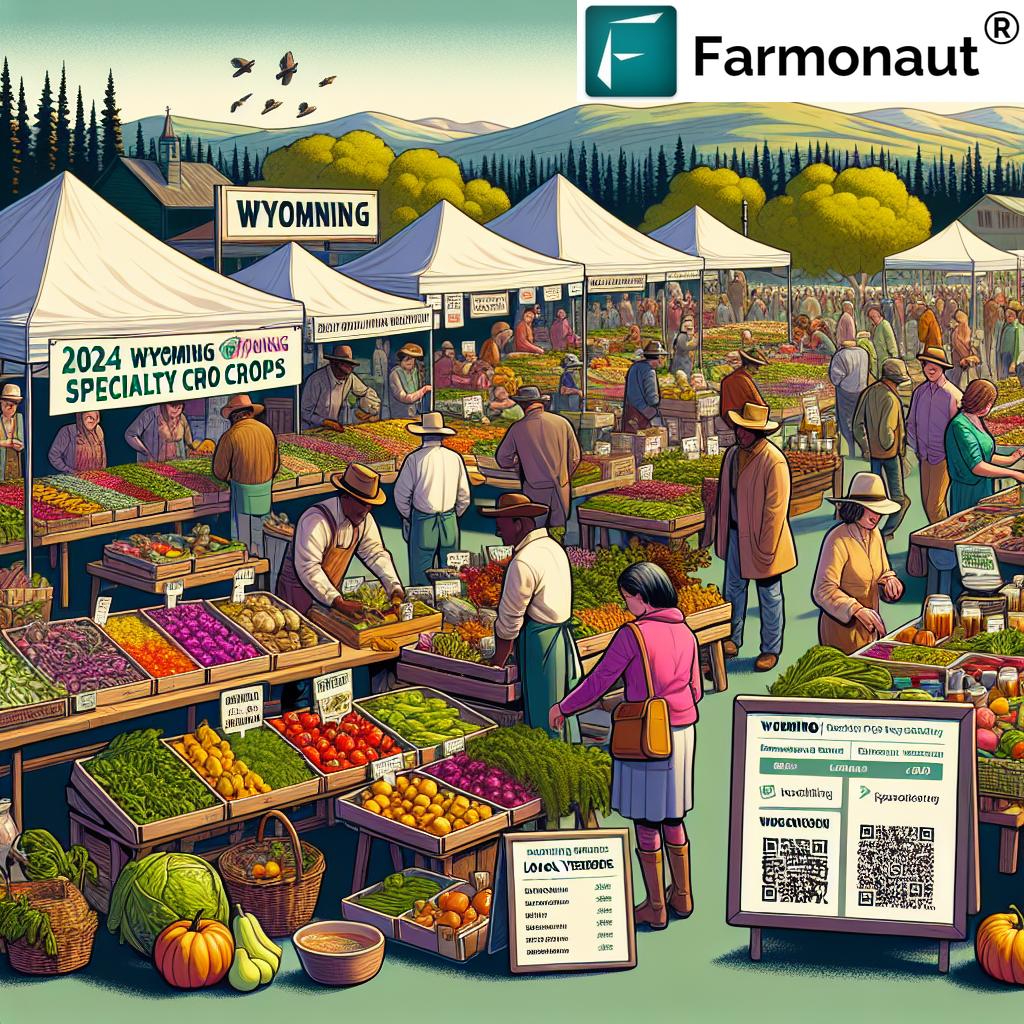Global Grain Market Trends: CBOT Wheat Futures and South America Crop Outlook
“CBOT wheat futures trading volume exceeds 100,000 contracts daily, reflecting global grain market volatility.”
In the ever-evolving landscape of global agriculture, we find ourselves at a critical juncture where grain futures trading and agricultural commodity prices are shaping the future of food production and international trade. As representatives of Farmonaut, a leading agricultural technology company, we’re here to provide you with a comprehensive analysis of the current global grain market trends, with a particular focus on CBOT wheat futures and the South America crop outlook.

The Chicago Board of Trade (CBOT) has recently reported mixed expectations for grain and soy complex trading, reflecting the complex interplay of global supply and demand factors. In this article, we’ll delve deep into the intricacies of wheat, corn, and soybean futures, exploring how various factors such as weather conditions, geopolitical tensions, and shifting production patterns are influencing market dynamics.
CBOT Wheat Futures: A Mixed Bag
The wheat market has been experiencing a period of volatility, with CBOT wheat futures showing mixed trends. As of March 14, the CBOT May soft red winter wheat futures were down 1/2 cent at $5.62 per bushel. This slight downturn is part of a larger pattern of fluctuations that we’ve been observing in recent weeks.
Several factors are contributing to these market movements:
- Russian Export Forecasts: The IKAR consultancy has recently cut its baseline 2024/25 wheat export forecast for Russia, the world’s largest supplier, to around 41 million tons from 42.5 million tons. This reduction in expected exports from a major player like Russia has helped underpin wheat prices, preventing a more significant decline.
- Ukrainian Spring Wheat Planting: In Ukraine, farmers are expected to increase their spring wheat planting this year, according to the country’s agriculture minister. This potential increase in production could help offset some of the supply concerns stemming from reduced Russian exports.
- Hard Red Winter Wheat Performance: While soft red winter wheat saw a slight decline, K.C. May hard red winter wheat futures were up 2 cents at $5.89-1/2 per bushel. This divergence highlights the importance of considering different wheat varieties when analyzing market trends.
- Spring Wheat Outlook: Minneapolis May spring wheat futures rose 3/4 cent to $6.04-1/2 per bushel, indicating a slightly more optimistic outlook for this variety.
These varied trends across different wheat types underscore the complexity of the global wheat market and the need for farmers and traders to stay informed about specific varietal performance.
Corn Futures: Facing Headwinds
The corn market is currently facing some challenges, with futures weakening overnight. The primary concerns revolve around potential impacts on U.S. agricultural exports due to ongoing trade tensions. Here’s what we’re seeing in the corn sector:
- Price Pressure: Corn futures are down 3 to 5 cents a bushel, reflecting market jitters about export prospects.
- Currency Fluctuations: The U.S. dollar’s performance against major peers has been volatile, starting the week poorly but subsequently bouncing back. A stronger dollar can make U.S. farm goods less attractive to importers, potentially dampening demand.
- Export Sales: Despite these challenges, there are some positive signs. The U.S. Department of Agriculture (USDA) reported that exporters sold 218,604 metric tons of U.S. corn to unknown destinations for 2024-25 delivery. This sale demonstrates that there’s still international demand for U.S. corn, even in the face of economic headwinds.
As we navigate these market conditions, it’s crucial for corn producers to stay agile and informed. Tools like Farmonaut’s satellite-based crop health monitoring can help farmers optimize their corn production, ensuring they’re well-positioned to meet market demands efficiently.
Soybean Market: South America’s Influence
The soybean market is currently in a state of consolidation as traders assess South America’s production prospects. This region, particularly Brazil and Argentina, plays a crucial role in global soybean supply and can significantly impact prices. Let’s break down the key factors at play:
- Brazilian Harvest Expectations: Brazil, the world’s top soybean supplier, is anticipated to produce a massive soybean harvest this year. This expectation of abundant supply is weighing on the market, potentially putting downward pressure on prices.
- Argentine Weather Conditions: In Argentina, recent rains have benefited crops. However, the Rosario Grains Exchange has lowered its outlooks for both soybean and corn harvests in the country. This mixed picture from Argentina adds another layer of complexity to the market.
- U.S. Soybean Oil Sales: The USDA reported that exporters sold 20,000 metric tons of U.S. soyoil to unknown destinations for 2024-25 delivery. While this is a positive sign for the U.S. soy complex, it’s a relatively small quantity in the grand scheme of global trade.
- CBOT Soybean Futures: As of the latest report, CBOT May soybeans were up 1/2 cent at $10.11-1/4 per bushel. This slight increase suggests that the market is finely balanced between the bearish pressure of expected large South American supplies and other supportive factors.
For soybean farmers, these market dynamics underscore the importance of efficient production and strategic planning. Utilizing advanced agricultural technologies, such as Farmonaut’s AI-driven advisory system, can help farmers make informed decisions about planting, management, and harvesting to maximize their yields and profitability in this competitive global market.
Global Supply and Demand Factors
The intricate balance of global supply and demand is at the heart of grain futures trading. Several key factors are currently shaping this balance:
- Weather Patterns: Unpredictable weather conditions in major producing countries continue to be a significant factor influencing crop prospects. Drought, excessive rainfall, or extreme temperatures can quickly alter production estimates and market outlooks.
- Geopolitical Tensions: Ongoing trade disputes and geopolitical issues can disrupt established trade flows and create uncertainty in the market. The potential for new tariffs or trade barriers remains a concern for U.S. agricultural exports.
- Shifting Production Patterns: Changes in crop production across key regions, including South America and the Black Sea region, are reshaping the global agricultural landscape. These shifts can have profound impacts on export competition and price dynamics.
- Economic Factors: Currency fluctuations, changes in global economic growth projections, and shifts in consumer dietary preferences all play roles in shaping demand for various grains and oilseeds.
Understanding these global factors is crucial for anyone involved in the grain market, from farmers to traders to policymakers. At Farmonaut, we’re committed to providing tools and insights that help agricultural stakeholders navigate these complex market dynamics.
“South America’s soybean production accounts for over 50% of global exports, significantly impacting worldwide supply.”
The Role of Technology in Modern Agriculture
As we analyze these market trends, it’s clear that staying competitive in today’s agricultural landscape requires more than just understanding market dynamics. It demands the integration of cutting-edge technology to optimize production, reduce costs, and make informed decisions. This is where Farmonaut’s suite of agricultural technology solutions comes into play.
- Satellite-Based Crop Health Monitoring: Our advanced satellite imagery analysis provides real-time insights into crop health, helping farmers identify issues before they become serious problems.
- AI-Driven Advisory System: Farmonaut’s Jeevn AI delivers personalized recommendations based on real-time data, weather forecasts, and expert knowledge, enabling farmers to make data-driven decisions.
- Blockchain-Based Traceability: For agribusinesses concerned about supply chain transparency, our blockchain solutions offer unparalleled traceability from farm to consumer.
- Resource Management Tools: Efficient resource allocation is crucial in today’s competitive market. Our platform provides tools for optimizing water usage, fertilizer application, and other critical inputs.
By leveraging these technologies, farmers and agribusinesses can better position themselves to thrive in the face of market volatility and changing global dynamics.
Global Grain Market Outlook: Key Commodities and Regions
| Commodity | CBOT Futures Trend | Major Exporter Outlook | South America Crop Prospects |
|---|---|---|---|
| Wheat (Soft Winter) | ↓ Slightly Bearish | U.S.: Stable Russia: Reduced exports expected |
Limited impact |
| Wheat (Hard Winter) | ↑ Slightly Bullish | U.S.: Potential for increased exports | Limited impact |
| Wheat (Spring) | ↑ Slightly Bullish | Canada: Stable outlook Ukraine: Increased planting expected |
Limited impact |
| Corn | ↓ Bearish | U.S.: Concerns over export demand Ukraine: Uncertain due to ongoing conflicts |
Argentina: Reduced harvest outlook Brazil: Stable production expected |
| Soybeans | → Mixed | U.S.: Stable, with some export sales reported | Brazil: Massive harvest expected Argentina: Improved conditions, but reduced harvest outlook |
Looking Ahead: Future Trends and Challenges
As we look to the future of global grain markets, several key trends and challenges emerge:
- Climate Change Impacts: Increasing frequency of extreme weather events could lead to more volatile production patterns and prices.
- Technological Adoption: The continued integration of precision agriculture technologies, like those offered by Farmonaut, will be crucial for maintaining competitiveness.
- Shifting Trade Patterns: Ongoing geopolitical tensions and the emergence of new agricultural powerhouses may reshape traditional trade flows.
- Sustainability Concerns: Growing emphasis on sustainable agriculture practices could influence production methods and market preferences.
- Population Growth and Changing Diets: Increasing global population and evolving dietary preferences in developing countries will continue to drive demand for grains and oilseeds.
Navigating these trends will require a combination of market intelligence, technological innovation, and adaptive strategies. Farmonaut is committed to supporting farmers and agribusinesses in meeting these challenges head-on.
Conclusion: Embracing Technology for Agricultural Success
The global grain market is a complex and dynamic system, influenced by a myriad of factors ranging from weather patterns to international trade policies. As we’ve explored in this analysis, current trends in CBOT wheat futures and South American crop outlooks highlight the interconnectedness of global agricultural markets.
For farmers, traders, and policymakers alike, staying informed and adaptable is key to success in this ever-changing landscape. This is where the power of agricultural technology comes into play. Farmonaut’s suite of tools, from satellite-based crop monitoring to AI-driven advisory systems, empowers agricultural stakeholders to make data-driven decisions, optimize their operations, and navigate market volatility with confidence.
As we move forward, the integration of advanced technologies in agriculture will become increasingly crucial. By embracing these innovations, we can work towards a more resilient, efficient, and sustainable global food system capable of meeting the challenges of the 21st century.

For those looking to leverage cutting-edge agricultural technology in their operations, we invite you to explore Farmonaut’s offerings. Our platform is designed to provide valuable insights and tools for farmers of all sizes, helping you optimize your production and stay ahead in today’s competitive agricultural landscape.
Earn With Farmonaut: Affiliate Program
Earn 20% recurring commission with Farmonaut’s affiliate program by sharing your promo code and helping farmers save 10%. Onboard 10 Elite farmers monthly to earn a minimum of $148,000 annually—start now and grow your income!
FAQs
- What factors are currently influencing CBOT wheat futures?
CBOT wheat futures are influenced by factors such as export forecasts from major producers like Russia, planting intentions in key regions like Ukraine, and global supply and demand dynamics. - How is South America’s crop production affecting global grain markets?
South America, particularly Brazil and Argentina, plays a significant role in global soybean and corn production. Large harvests in these countries can put downward pressure on global prices, while crop shortfalls can lead to price increases. - What role does technology play in modern agriculture?
Technology, such as Farmonaut’s satellite-based crop monitoring and AI advisory systems, helps farmers optimize production, reduce costs, and make data-driven decisions in the face of market volatility and changing environmental conditions. - How can farmers stay informed about global grain market trends?
Farmers can stay informed by utilizing agricultural technology platforms like Farmonaut, following reports from organizations like the USDA, and keeping abreast of geopolitical and weather-related news that could impact agricultural markets. - What are the main challenges facing the global grain market in the coming years?
Key challenges include climate change impacts, geopolitical tensions affecting trade, the need for sustainable farming practices, and meeting growing global food demand amid resource constraints.
















